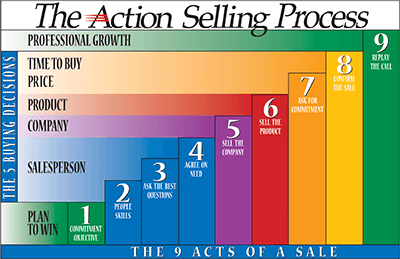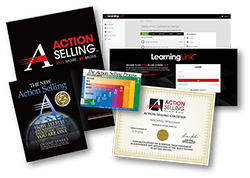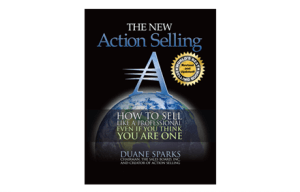
A WORD FROM DUANE SPARKS
Dear Sales Executive:
How many excuses have you heard for somebody’s failure to close a sale? How many excuses have you made yourself? Here’s a thought: Sometimes the reason you can’t close a sale is because the sale was never opened to begin with.
In the last edition of eCoach, I shared the research finding that 64% of salespeople don’t close. I detailed three reasons why that is. And, I shared some examples of manipulative closing techniques that have been used in the past, with little or no success.
In this edition, I want to back up a bit and talk about how to “open” a sale so that you can actually gain a commitment to move forward. Notice that I didn’t use the term “close.” There is a reason for that. Please read on.
If you have a question about how to open a sale so you can Ask for Commitment, click on “Ask The eCoach“.
We are committed to your professional success.
Duane Sparks
Author of Action Selling ®
HOW TO OPEN A SALE
I hate the term “close” as it applies to sales. The word implies that you are ending or shutting down something. The truth is, if you wish to gain a customer’s commitment, you don’t want to end anything. You want to begin or continue the customer relationship.
The act of Gaining Commitment is a natural conclusion to a well-orchestrated sales conversation. Highly skilled salespeople know that sales conversations must first include steps that open a sales opportunity. When the process is done correctly, you’ll actually see and hear the opening happen. The customer’s body language may give you a clue. Even if it doesn’t, you’ll begin to hear questions or comments that indicate a customer is open to buying from you.
That “open” generally won’t happen unless you make it happen. A properly orchestrated sales conversation progresses through certain steps or “acts” that must be completed so that you get an opportunity-an opening-to ask for commitment.
You need an opening before you can Ask for Commitment.
Research on how customers make major purchasing decisions shows that they actually make a series of incremental decisions. These decisions are always made in the same predetermined order: Salesperson, Company, Product/Service, Price, Time-to-Buy.
That is, a buyer first decides whether to “buy” the salesperson, then whether to buy the salesperson’s company, then whether to buy the product, and so on.
The best way to make a sale is to help the customer make all of these decisions in the proper sequence. The sales methodology that follows this decision sequence is (you guessed it) Action Selling ®. The 9 Acts of Action Selling ® are like a road map that allows sales calls to be orchestrated in a way that proactively helps customers make buying decisions.

You “open” a sale during what we call Acts 3 and 4. During Act 3 (“Ask the Best Questions”), you learn about the customer’s situation and needs. In Act 4 (“Agree on Need”), you restate the needs the customer articulated during Act 3 and ask a question to confirm the customer’s agreement that these are, in fact, the key needs and concerns.
When Act 4 is done correctly, you “open the sale.” Act 4 is short, but it is absolutely critical to gaining the customer’s commitment to move forward in your sales process. It goes like this: “As I understand it you’re looking for _____________, _____________, and ____________. Is that correct?” (Fill in the blanks with the customer’s unique needs.)
When you remember to do Act 4, not only do you and the customer know (and agree) what the customer’s needs are, but the customer knows that YOU know. That’s a relief for both of you. It writes the agenda for the rest of your sales interaction.
Now, and only now, is the sale open.
Once that opening happens, there is no way in the world you want to “close” the deal. You just want to gain the customer’s commitment to keep on deepening the relationship.
For a vivid and enjoyable look at how to open a sale, get my newly revised and updated book Action Selling ®: How to Sell Like a Professional, Even if You Think You are One.
Action Selling ® in Action.
A great example of an organization that fully understands the importance of “opening a sale” before you try to gain someone’s commitment is Cincinnati Children’s Hospital. The hospital also has what I’d call a very non-traditional sales organization.
Patty Branson, director of physician services, leads a team of medical professionals who call on doctors to encourage them to refer their patients to Children’s Hospital.
“Cincinnati Children’s Hospital serves the special medical and surgical needs of children,” Branson says.
“We want parents of children in need—and the doctors who would refer them—to think of us as the best alternative when these needs arise.”
Branson knew the issue she faced was essentially a sales challenge, but she had to do some shopping herself before she discovered our program Action Selling ® Customer Relationship Professional.
“We attended a Dale Carnegie course in the past,” she says, “but even though it had some takeaways, it didn’t fit well for us. We don’t see ourselves as salespeople, even though we realize we need to gain commitments. The Action Selling ® CRP training taught us a better way to manage our conversations with doctors.
“One key thing we learned,” Branson continues, “was how to identify key needs for quality healthcare and then match our capabilities to solve the problems that actually exist in each doctor’s practice. Every situation is different, but we see sales opportunities open up when we follow the Action Selling ® CRP process. Gaining commitment is far easier to accomplish.”
For information about how to make sales training pay huge dividends, contact The Sales Board at (800) 232-3485.
Get my newly revised and updated book Action Selling ®: How to Sell Like a Professional, Even if You Think You are One.
Recent eCoaches
Don’t Look Now, But Your Sales Culture Gap is Growing
Close Your Culture Gap! Align Sales and Service
Why 64% of Salespeople Don’t Close
Stalls Vs. Objections: No, They Don’t Have the Same Solution
No Detours! Why Must You Leave the Sales Path Just to Handle an Objection?
I Object! (To the Way You Define Objections)
How to Train Your Way Out of a Sales Slump
It’s Not What You Sell, It’s How You Sell
How Do You Know If Your Sales Force Is Good?
“One Call” Close Not Dead Yet?
TQM for Sales Leadership? Yes!
Six Critical Processes for Sales Leaders
10 Great Ideas About Sales Leadership
The Three Core Roles of Every Sales Leader
The Nine Acts of Sales Leadership
5 Secrets to Record-Breaking Sales
Sales Training That Actually Works
The Sales Leader’s Toughest Challenge
How Strong is Your Sales Culture?
Want to Create the Best Sales Culture?


ASSESS YOUR SALES SKILLS
Unlock your hidden sales potential today – take our free Selling Skills Assessment.

THE NEW ACTION SELLING
A Quick Read That Will Boost Your Sales — Guaranteed!


